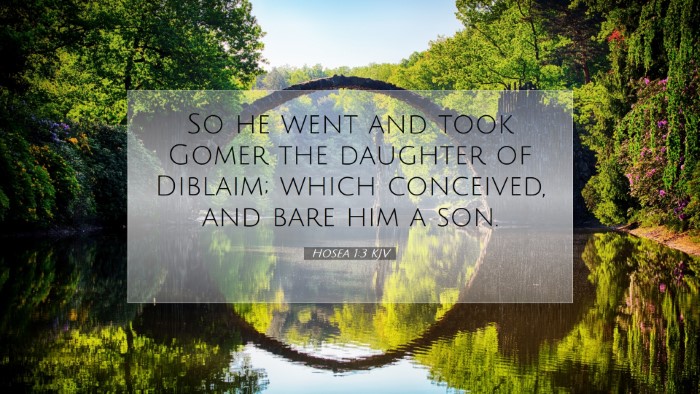Old Testament
Genesis Exodus Leviticus Numbers Deuteronomy Joshua Judges Ruth 1 Samuel 2 Samuel 1 Kings 2 Kings 1 Chronicles 2 Chronicles Ezra Nehemiah Esther Job Psalms Proverbs Ecclesiastes Song of Solomon Isaiah Jeremiah Lamentations Ezekiel Daniel Hosea Joel Amos Obadiah Jonah Micah Nahum Habakkuk Zephaniah Haggai Zechariah MalachiHosea 1:3
Hosea 1:3 KJV
So he went and took Gomer the daughter of Diblaim; which conceived, and bare him a son.
Hosea 1:3 Bible Commentary
Bible Commentary on Hosea 1:3
Bible Verse: “So he went and took Gomer the daughter of Diblaim, which conceived, and bare him a son.” (Hosea 1:3)
Overview
The book of Hosea, attributed to the prophet Hosea, is set during a turbulent period in the history of Israel characterized by moral decay and spiritual infidelity. Hosea's marriage to Gomer serves as a vivid symbolism of God's relationship with Israel. This verse specifically depicts an act of obedience as Hosea is commanded by God to marry an unfaithful wife, which serves to illustrate the themes of love, judgment, and redemption within the broader narrative of the prophetic literature.
Context of Hosea's Prophecy
Hosea prophesied during the reign of several kings in Israel, particularly around the 8th century BC. His contemporary prophets, such as Amos, shared similar messages of impending judgment but differed in their stylistic and theological emphases. Hosea's primary concern was to portray God's steadfast love amidst Israel's unfaithfulness.
Commentary Insights
-
Matthew Henry's Insights
Matthew Henry emphasizes that the act of taking Gomer reflects Hosea's commitment to follow God’s command, regardless of personal circumstances. The selection of Gomer, described as a harlot, symbolizes the moral decline of Israel and God's willingness to engage with His unfaithful people. Henry points out the tenderness of God's dealings, demonstrating immense grace by choosing to love a people who are prone to wander from the truth.
-
Albert Barnes' Observation
Albert Barnes highlights the symbolic nature of Gomer's name, which indicates “completion.” This completes the metaphor that God’s plan includes purification through judgment leading to restoration. Barnes surmises that Gomer’s unfaithfulness represents Israel’s idolatry and social injustices, underscoring the theme of divine love that seeks to reclaim lost souls. He notes that Hosea’s willingness to marry Gomer illustrates God’s unyielding pursuit of His people.
-
Adam Clarke's Analysis
Adam Clarke discusses the narrative's implications of prophetic action. He articulates that Hosea's command to marry Gomer serves not only as a personal narrative but as a public proclamation of Israel’s spiritual condition. Clarke insists that this relationship embodies the covenant faithfulness of God despite the people's infidelity. He sees Gomer's subsequent children as manifestations of God’s judgment, reflecting the serious repercussions of sin while simultaneously hinting at the hope of future restoration.
Theological Implications
Hosea 1:3 encapsulates several important theological themes:
-
Covenantal Love:
The act of marrying Gomer serves to signify God's covenantal love for His people, despite their waywardness. This invitation to relationship emphasizes that love is often steadfast, irrespective of unfaithfulness.
-
Sin and Judgment:
Gomer's unfaithfulness points to the pervasive sinfulness within Israel. The judgment that follows symbolizes God's holiness and justice; yet, this passage also encapsulates hope, suggesting that after judgment, restoration is possible.
-
Prophetic Demonstration:
Hosea's life becomes a living parable, illustrating the deep, emotional reality of God's relationship with His people. This prophetic demonstration urges the audience to grasp the gravity of their rebellion against God.
Practical Applications
This verse offers numerous applications to contemporary audiences:
-
Understanding God's Grace:
Their failures do not exclude them from God's love. Church leaders and congregants alike can find assurance in God’s willingness to forgive and seek reconciliation.
-
Call to Faithfulness:
Just as Israel was called to return to faithfulness, believers are similarly reminded to uphold the covenant they have with God through Christ. Spiritual fidelity is thus emphasized as a communal and personal responsibility.
-
Bold Obedience:
The command given to Hosea encourages modern believers to reflect on their responsiveness to God’s directives, especially when such directives lead to uncomfortable or challenging circumstances.
Conclusion
Hosea 1:3 serves as a profound reminder of God's unwavering love and pursuit for a people prone to forsake Him. The marriage of Hosea to Gomer encapsulates the coexistence of judgment and mercy, inviting believers to deeply consider the seriousness of sin while rejoicing in the hope of redemption. As such, this verse remains a vital resource for pastors, students, theologians, and scholars, nourishing their theological understanding and practical application of faith.


